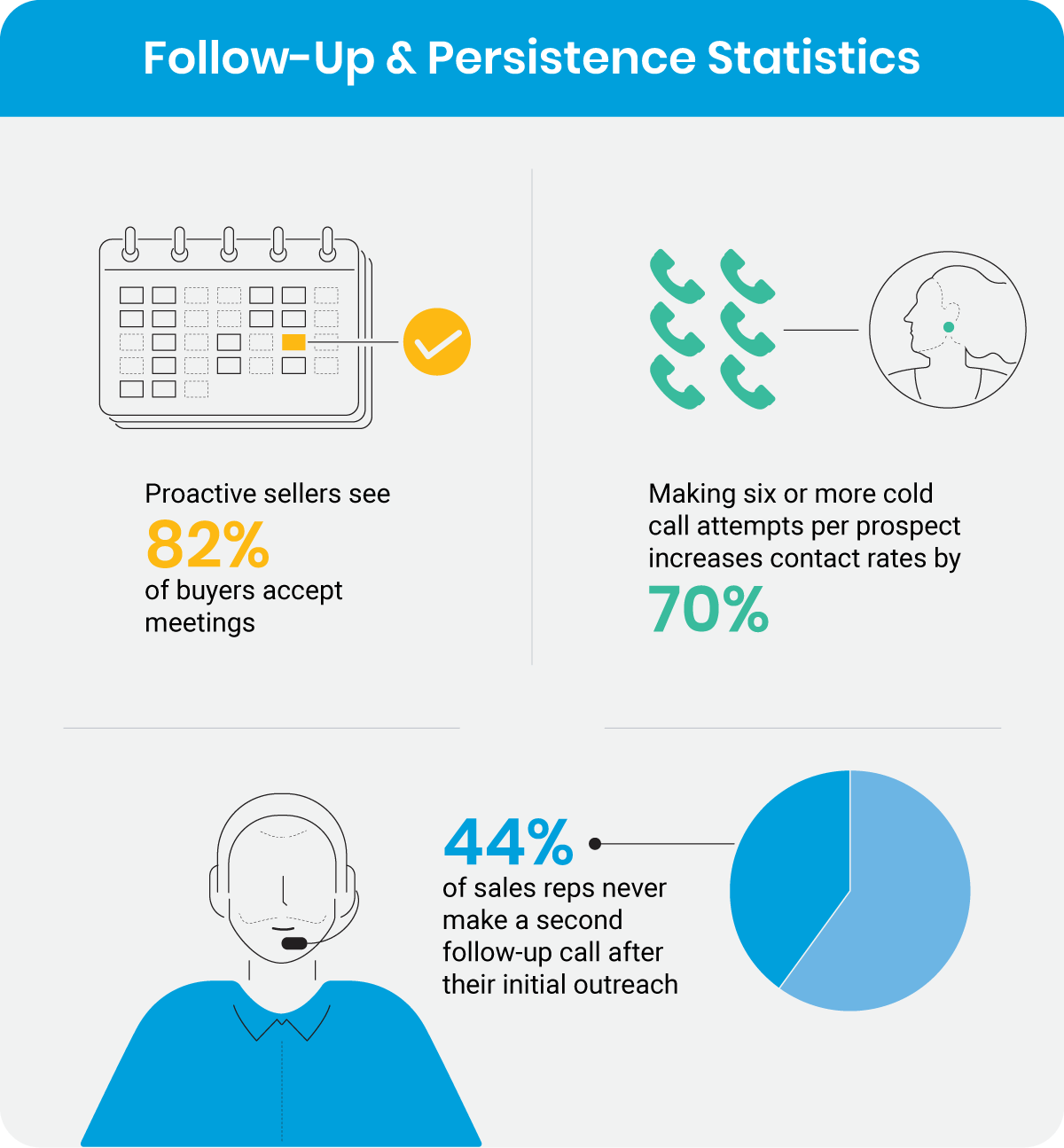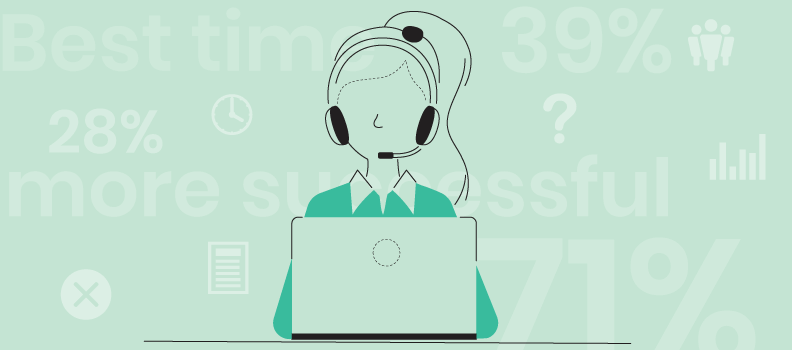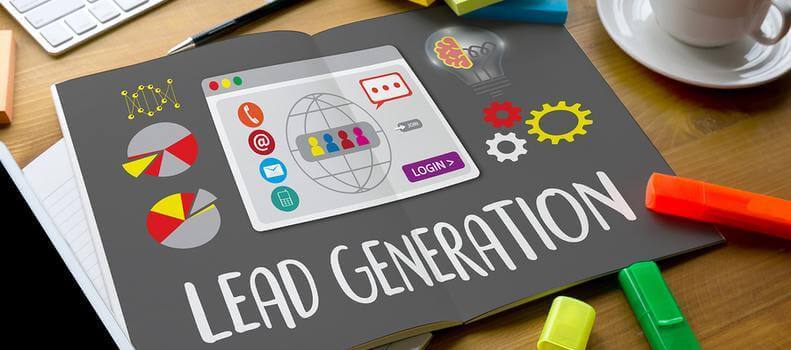Cold calling can be a daunting task for many sales professionals. It requires a great deal of confidence, persistence, and the ability to handle rejection. Yet, it remains one of the most powerful tools sales representatives have in their arsenal. Despite the rise of digital marketing, cold calling still provides direct, immediate access to decision-makers, making it an essential sales strategy tactic.
Did you know that calling leads within the first minute of lead creation can improve conversion rates by nearly 400%? Having accurate data ensures your sales team connects with the right prospects at precisely the right time, boosting the likelihood of meaningful interactions and conversions.
In this article, we’ll explore insightful cold calling statistics covering success rates, optimal call timings, objection handling, follow-up strategies, and more. Additionally, you’ll find actionable, high-impact tips designed to enhance your cold calling effectiveness, helping you secure more meetings and close more deals in 2025.
Top 18 Cold Calling Stats for Sales Success in 2025
Core Cold Calling Benchmarks: What the Data Says
Cold calling statistics continue to prove that this outreach method is far from outdated. Cold calling remains an essential channel for connecting with prospects, so understanding key benchmarks can help your team manage their time effectively and engage potential buyers early. Key cold calling stats include:
- Average cold-call length is between 2–3 minutes.
PRO TIP: Get to the point. Keep calls concise and purposeful; clearly state your value proposition within the first minute to maximize engagement.
- 71% of buyers prefer hearing from sellers early in their buying process, specifically when exploring new ideas and possibilities.
PRO TIP: Think long term. Engage prospects early by positioning your outreach as educational, offering insights rather than pushing an immediate sale.
- Cold calling success statistics show only a 2% cold calling success rate.
PRO TIP: Sharpen your targeting and personalize openers to beat the industry average cold call sales statistics.

B2B Cold Calling Statistics: The Critical Role of Data Accuracy
Reliable data is the backbone of successful B2B cold calling. These statistics highlight just how dramatically your success rates can improve when your data is accurate and consistently updated:
- B2B data decays at approximately 2.1% per month, totaling about 22.5% annually.
PRO TIP: Schedule monthly data refreshes and validation checks to minimize wasted calls and maintain accurate targeting.
- Inaccurate data can cost companies to lose up to 12% of their revenue.
PRO TIP: Integrate routine data hygiene into your workflow, such as quarterly database cleaning, to maximize leads generated from your cold calling campaigns.
- Poor data quality costs organizations an average of $12.9 million per year.
PRO TIP: Quantify the ROI of data-cleaning initiatives. Recapturing even a fraction of that lost revenue can quickly offset the cost of data-quality tools and processes.
Cold Calling Success-Rate Statistics: How to Improve Your Conversion
Taking a look at cold calling success statistics offer invaluable insights into what separates top-performing sales reps from the average. To boost your cold calling success rate, use these benchmarks to refine your sales strategy and improve outcomes:
- The average cold calling success rate is now approximately 4.8% (up from 2% in previous years).
PRO TIP: Track your cold calling stats monthly. If you’re below this benchmark, it’s time to optimize lead targeting and enhance your call scripts.
- Predictive dialers can triple connection rates compared to manual dialing methods.
PRO TIP: Invest in predictive dialing technology to significantly reduce idle time and improve live-answer rates.
- Using AI call analysis technology can improve your success rates by 50%.
PRO TIP: Retain cold calling as a key channel in your sales mix; even moderate cold calling volumes significantly outperform strategies that omit calling entirely.
- It takes approximately 7 hours of cold calling and follow-ups to secure one face-to-face meeting.
PRO TIP: Maintain a routine. Schedule regular, distraction-free “power hour” call blocks early in your day to maximize productivity and ensure consistent appointment-setting results.

Optimal Calling-Time Statistics: Maximize Connection Rates
Timing is critical to the success of your cold calling strategy. Knowing exactly when to reach out increases your chances of connecting, having meaningful conversations, and ultimately closing deals. These optimal calling-time stats provide clear windows to help sales representatives make every dial count:
- The best time to cold call prospects is between 11 a.m. and 12 p.m., and between 4:00 p.m. and 5:00 p.m., as this hour typically yields the highest connection rates.
PRO TIP: Prioritize your highest-value or hardest-to-reach prospects during this prime calling window, reserving administrative tasks for lower-activity time periods.
- Wednesdays deliver the highest cold-call connect rates—up to 50% more conversations than other weekdays.
PRO TIP: Front-load prospecting activities mid-week, capitalizing on higher response rates, and reserve Mondays for prospect research and preparation.
Follow-Up & Persistence Statistics: Boost Your Cold Calling Success Rate
Persistence often distinguishes successful sales professionals from the rest. The following stats demonstrate the importance of continued outreach, highlighting exactly how many calls are needed and the value of proactive follow-ups:
- Proactive sellers see 82% of buyers accept meetings.
PRO TIP: Take the initiative to engage prospects consistently. Buyers typically respond positively when you’re proactive, clear, and helpful.
- Making six or more cold call attempts per prospect increases contact rates by 70%.
PRO TIP: Develop consistent multi-call cadences. Don’t give up at just one or two attempts. Persistence substantially improves your likelihood of success.
- 44% of sales reps never make a second follow-up call after their initial outreach.
PRO TIP: Simply committing to at least one additional follow-up call can set you apart from nearly half your competition.

Running Successful Demo Calls Statistics: Proven Techniques That Close Deals
Discovery and demo calls are pivotal opportunities to turn prospects into customers. To make the most of these conversations, see some proven methods that help top sellers close below:
- Top-performing sales representatives ask 39% more questions during discovery calls than their peers.
PRO TIP: Prepare a targeted list of 8-10 high-impact discovery questions that reveal underlying needs, priorities, and decision criteria early in the call.
- Top reps conduct discovery calls that are 76% longer.
PRO TIP: Always schedule ample time for discovery calls so you can explore issues deeply without rushing key insights or overlooking critical details.
- Top-performing salespeople speak at an average of 171 words per minute, compared to 182 words per minute for lower performers.
PRO TIP: Maintain a steady, deliberate pace during your calls. Slowing your speech down signals confidence, clarity, and gives prospects more mental space to consider your solutions.
What is the Future of Cold Calling?
Cold calling isn’t going away; in fact, it’s rapidly evolving. As buyers become savvier and competition increases, traditional methods alone won’t suffice. Moving forward, cold calling will rely heavily on personalization, intent-based targeting, and multi-channel integration.
Ideally, teams will leverage real-time intent data to pinpoint exactly when and why prospects are interested, ensuring calls happen at the most receptive moments. Additionally, technologies such as conversational AI, automated dialers, and personalized video messaging will become standard tools, empowering reps to reach decision-makers efficiently and effectively.
Ultimately, the future belongs to sales professionals who seamlessly blend data-driven insights, targeted personalization, and genuine human connection into their cold-calling strategies.
7 High-Impact Cold Calling Tips to Increase Your Win Rate
Considering the above statistics, you can implement these practical tips to significantly enhance your cold-calling effectiveness:
- Lead with Curiosity, Not a Pitch: Open conversations with genuine curiosity about the prospect’s situation, fostering trust and engagement.
- Prioritize Data Quality: Regularly update and verify your prospect data to reduce wasted time and ensure accurate targeting.
- Master Your Opening Line: Craft concise, personalized openers that directly reference the prospect’s industry, role, or recent company developments.
- Practice Active Listening: Aim to speak less and listen more. You can use prospects’ answers to lock down a sale.
- Schedule Calls Strategically: Align your calls with proven optimal times, such as late afternoon or mid-morning, to improve connection rates.
- Follow Up Persistently and Politely: Commit to at least 6–8 touchpoints per prospect, using multiple channels (phone, email, social media) to stay top-of-mind.
- Speak Slower and Clearly: Slow down your speaking pace to convey confidence and help prospects absorb your message more effectively.
Key Takeaways
Cold calling continues to be a high-impact sales strategy, especially when powered by data, timing, and persistence. As we move through 2025, sales professionals who embrace the evolving best practices of cold calling outreach will significantly outperform the competition. Here’s what you should remember:
- Timing is Everything: Calling between 11 a.m.–12 p.m. and 4–5 p.m., especially on Wednesdays, delivers the highest connect rates.
- Speed to Lead Pays Off: Reaching a lead within the first minute can significantly boost conversion rates.
- Data Quality Drives Results: With B2B data decaying at over 22% annually, consistent data hygiene is essential to avoid revenue loss and improve targeting accuracy.
- Persistence Wins: It takes more than six attempts to significantly increase contact rates, yet nearly half of reps stop after just one follow-up.
- Discovery is a Differentiator: Top-performing sales reps ask more questions and hold longer discovery calls, leading to stronger connections and better close rates.
- Technology is Your Ally: Tools like predictive dialers and AI-driven call analysis can meaningfully improve efficiency and success rates.
- Human Connection Still Matters: Slower speech, active listening, and personalized openers create trust and engagement, which are essential in converting cold calls into qualified leads.
By integrating these insights and statistics into your daily routine, you’ll not only increase your call success rate, but you’ll also build lasting customer relationships that convert into long-term business. Stay informed, stay proactive, and let the numbers guide your strategy.
FAQs
Yes, cold calling remains highly effective in 2025. Despite digital channels, direct human interactions still strongly influence buyers, especially in B2B sales where relationships and trust are essential.
Both can be effective, but cold calling often yields quicker responses and deeper interactions, enabling immediate relationship-building. Cold emailing is effective at scale but generally has lower engagement per contact.
Most successful sales professionals average around 60 cold calls per day. Prioritize call quality and meaningful conversations over sheer volume to avoid burnout and maximize results.
On average, it takes about eight calls to book one qualified meeting. Persistently following up and personalizing each outreach can reduce this number significantly.
It takes an average of about 8–10 hours to complete 100 well-prepared cold calls, factoring in actual conversations, voicemail messages, and brief notes between calls.
According to recent data, the average cold calling success rate in 2024 was approximately 4.82%. However, personalization, strategic timing, and follow-up efforts can greatly increase your individual conversion rate.






